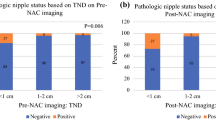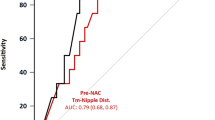Abstract
Nipple-sparing mastectomy (NSM) has recently been increasing in popularity due to a better cosmetic outcome and quality-of-life benefit. The radiologic distance between the tumor and the nipple is independently predictive of nipple-areolar complex involvement and can assist in patient selection for NSM. However, concordance between the preoperative radiologic imaging and histologic evaluation would play a major role in making patient selection for NSM meaningful. We analyzed the pathologic-radiologic correlation for evaluation of retroareolar (RA) margin in NSM. A retrospective histologic and blinded radiologic review of 80 NSM (41 therapeutic and 39 prophylactic) performed on 45 patients was done. Histologically, the cases were divided into positive or close (invasive or in situ carcinoma within 5 mm of the RA margin) and negative (greater than 5 mm from the RA margin). Radiographically, positive cases were defined as suspicious enhancement and/or suspicious findings within 20 mm of the nipple on magnetic resonance imaging (MRI) and/or diagnostic mammography, respectively. Thirty five of 41 (85.4 %) therapeutic cases were concordant. Six cases were discordant, with 2/41 (4.9 %) discordant cases classified as positive at histology, but negative on imaging and 4/41 (9.75 %) discordant cases classified as negative at histology, but positive on imaging. Agreement between pathology and radiology was moderate [kappa coefficient 0.54 (p = 0.0003)].We conclude that there is a significant agreement between histologic and radiologic evaluation for assessment of RA margin and preoperative radiologic imaging; specifically, MRI provides valuable information and should be strongly recommended to help select patients for NSM.




Similar content being viewed by others
References
Mallon P, Feron JG, Couturaud B et al (2013) The role of nipple-sparing mastectomy in breast cancer: a comprehensive review of the literature. Plast Reconstr Surg 131:969–984
Rusby JE, Smith BL, Gui GPH (2010) Nipple-sparing mastectomy. Br J Surg 97:305–316
Li W, Wang S, Guo X et al (2011) Nipple involvement in breast cancer: retrospective analysis of 2323 consecutive mastectomy specimens. Int J Surg Pathol 19:328–334
Didier F, Radice D, Gandini S et al (2008) Does nipple preservation in mastectomy improve satisfaction with cosmetic results, psychological adjustment, body image and sexuality? Breast Cancer Res Treat 118:623–633
Brachtel EF, Rusby JE, Michaelson JS et al (2009) Occult nipple involvement in breast cancer: clinicopathologic findings in 316 consecutive mastectomy specimens. J Clin Oncol 27:4948–4954
Vlajcic Z, Zic R, Stanec S et al (2005) Nipple-areola complex preservation: predictive factors of neoplastic nipple-areola complex invasion. Ann Plast Surg 55:240–244
Kissin MW, Kark AE (1987) Nipple preservation during mastectomy. Br J Surg 74:58–61
Schecter AK, Freeman MB, Giri D et al (2006) Applicability of the nipple–areola complex-sparing mastectomy: a prediction model using mammography to estimate risk of nipple–areola complex involvement in breast cancer patients. Ann Plast Surg 56:498–504
Loewen MJ, Jennings JA, Sherman SR et al (2008) Mammographic distance as a predictor of nipple–areola complex involvement in breast cancer. Am J Surg 195:391–394
Rusby JE, Brachtel EF, Othus M et al (2008) Development and validation of a model predictive of occult nipple involvement in women undergoing mastectomy. Br J Surg 95:1356–1361
Moon JY, Chang YW, Lee EH et al (2013) Malignant invasion of the nipple-areolar complex of the breast: usefulness of breast MRI. Am J Roentgenol 201:448–455
Untch M, Gerber B, Harbeck N et al (2013) 13th St. Gallen international breast cancer conference 2013: primary therapy of early breast cancer evidence, controversies, consensus—opinion of a German team of experts (Zurich 2013). Breast Care (Basel) 8:221–229
Harbeck N, Thomssen C, Gnant M (2013) St. Gallen 2013: brief preliminary summary of the consensus discussion. Breast Care (Basel) 8(2):102–109
Strigel RM, Eby PR, Demartini WB et al (2010) Frequency, upgrade rates, and characteristics of high-risk lesions initially identified with breast MRI. AJR Am J Roentgenol 195:792–798
Landis JR, Koch GG (1977) The measurement of observer agreement for categorical data. Biometrics 33:159–174
Lagios MD, Gates EA, Westdahl PR et al (1979) A guide to the frequency of nipple involvement in breast cancer: a study of 149 consecutive mastectomies using a serial subgross and correlated radiographic technique. Am J Surg 138:135–142
Jitendra J, Chinoy RF, Vaidyat JS (1998) Prediction of nipple and areola involvement in breast cancer. Eur J Surg Oncol 24:15–16
Pirozzi PR, Rossetti C, Carelli I et al (2010) Clinical and morphological factors predictive of occult involvement of the nipple-areola complex in mastectomy specimens. Eur J Obstet Gynecol Reprod Biol 148:177–181
Lüttges J, Kalbfleisch H, Prinz P (1987) Nipple involvement and multicentricity in breast cancer: a study on whole organ sections. J Cancer Res Clin Oncol 113:481–487
Cucin RL, Guthrie RH Jr, Luterman A et al (1980) Screening the nipple for involvement in breast cancer. Ann Plast Surg 5:477–479
Wijayanayagam A, Kumar AS, Foster RD et al (2008) Optimizing the total skin-sparing mastectomy. Arch Surg 143:38–45
Verma GR, Kumar A, Joshi K (1997) Nipple involvement in peripheral breast carcinoma: a prospective study. Indian J Cancer 34:1–5
Quinn RH, Barlow JF (1981) Involvement of the nipple and areola by carcinoma of the breast. Arch Surg 116:1139–1140
Khan K, Chakraborti S, Mondal S (2010) Morphological predictors of nipple areola involvement in malignant breast tumors. Indian J Pathol Microbiol 53:232–237
de Alcantara FP, Capko D, Barry JM et al (2011) Nipple-sparing mastectomy for breast cancer and risk-reducing surgery: the Memorial Sloan-Kettering Cancer Center experience. Ann Surg Oncol 18:3117–3122
Alperovich M, Tanna N, Samra F et al (2013) Nipple-sparing mastectomy in patients with a history of reduction mammaplasty or mastopexy: how safe is it? Plast Reconstr Surg 131:962–967
D’Alonzo M, Martincich L, Biglia N et al (2012) Clinical and radiological predictors of nipple-areola complex involvement in breast cancer patients. Eur J Cancer 48:2311–2318
Steen ST, Chung AP, Han S-H et al (2013) Predicting nipple–areolar involvement using preoperative breast MRI and primary tumor characteristics. Ann Surg Oncol 20:633–639
Billar JA, Dueck AC, Gray RJ et al (2011) Preoperative predictors of nipple–areola complex involvement for patients undergoing mastectomy for breast cancer. Ann Surg Oncol 18:3123–3128
Friedman EP, Hall-Craggs MA, Mumtaz H et al (1997) Breast MR and the appearance of the normal and abnormal nipple. Clin Radiol 52:854–861
Kneubil MC, Lohsiriwat V, Curigliano G et al (2012) Risk of locoregional recurrence in patients with false-negative frozen section or close margins of retroareolar specimen in nipple-sparing mastectomy. Ann Surg Oncol 19:4117–4123
Papa MZ, Zippel D, Koller M et al (1999) Positive margins of breast biopsy: is reexcision always necessary? J Surg Oncol 70:167–171
Gage I, Schnitt SJ, Nixon AJ et al (1996) Pathologic margin involvement and the risk of recurrence in patients treated with breast-conserving therapy. Cancer 78:1921–1928
Schnitt SJ, Abner A, Gelman R et al (1994) The relationship between microscopic margins of resection and the risk of local recurrence in patients with breast cancer treated with breast-conserving surgery and radiation therapy. Cancer 74:1746–1751
Pittinger TP, Maronian NC, Poulter CA et al (1994) Importance of margin status in outcome of breast-conserving surgery for carcinoma. Surgery 116:605–608
Kunos C, Latson L, Overmoyer B et al (2006) Breast conservation surgery achieving > or = 2 mm tumor-free margins results in decreased local-regional recurrence rates. Breast J 12:28–36
Eisenberg RE, Chan JS, Swistel AJ et al (2014) Pathological evaluation of nipple-sparing mastectomies with emphasis on occult nipple involvement: the Weill-Cornell experience with 325 cases. Breast J 20:15–21
Acknowledgments
Dr. Alison Chetlen and Dr. Susann Schetter were paid research consultants for Siemens in October and November 2014. This has no relation to the current research study. The other authors do not have any sources of support or disclosure of funding.
Conflict of interest
We declare that we have no conflict of interest.
Author information
Authors and Affiliations
Corresponding author
Additional information
Portions of this study were presented as an abstract/poster at the USCAP 2014 meeting, San Diego.
Rights and permissions
About this article
Cite this article
Karamchandani, D.M., Chetlen, A.L., Riley, M.P. et al. Pathologic-radiologic correlation in evaluation of retroareolar margin in nipple-sparing mastectomy. Virchows Arch 466, 279–287 (2015). https://doi.org/10.1007/s00428-014-1714-3
Received:
Revised:
Accepted:
Published:
Issue Date:
DOI: https://doi.org/10.1007/s00428-014-1714-3




